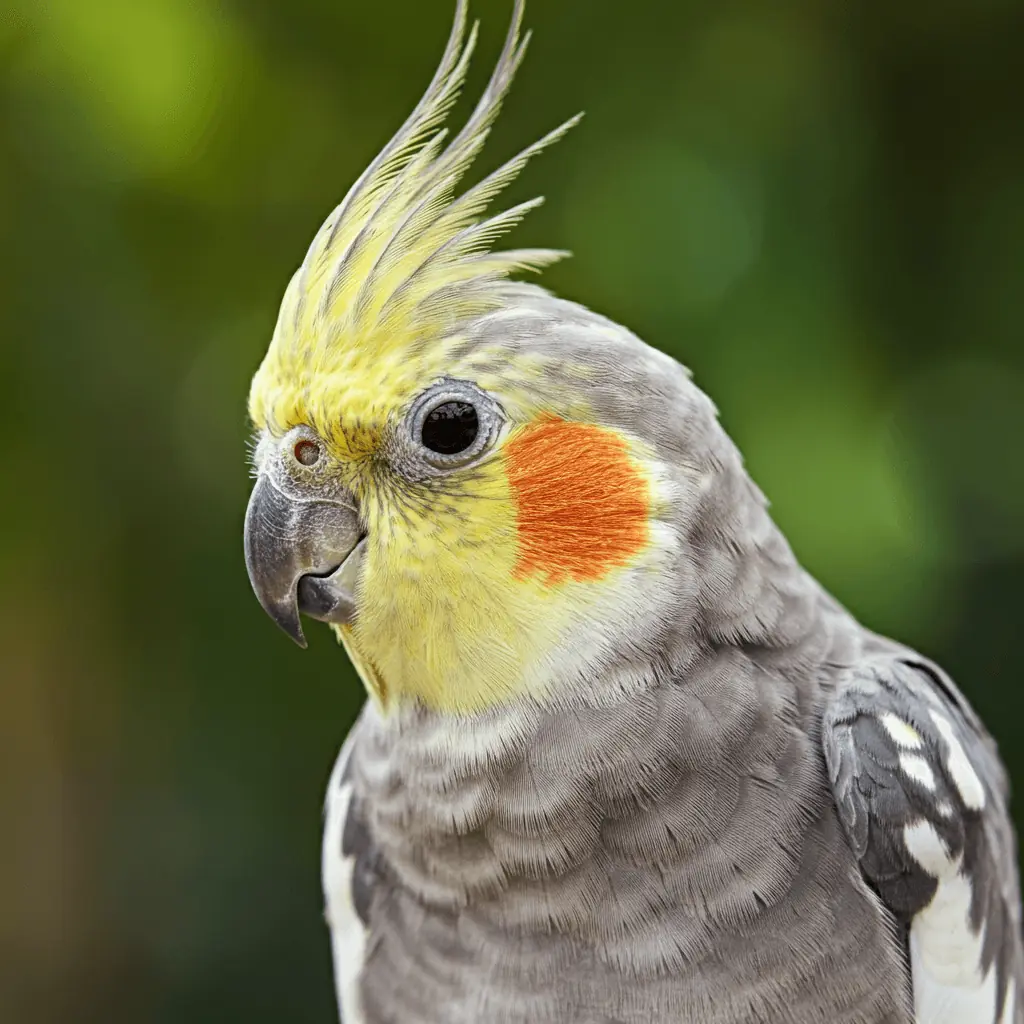Understanding the Importance of Beak Health in Cockatiels
Beak health plays a vital role in the overall well-being of your cockatiel. A healthy beak allows your bird to eat properly, groom itself, and explore its environment. Like fingernails on humans, cockatiel beaks grow continuously, which means regular maintenance is essential to prevent issues like overgrowth or deformities. Neglecting your cockatiel’s beak care can lead to serious health problems, including difficulty eating or even injury.
A well-maintained beak is usually smooth, symmetrical, and free from cracks or peeling. If your cockatiel’s beak looks overgrown or uneven, this could be a sign of a problem. It’s important to address these issues early by providing chew toys and a healthy diet, both of which help keep their beaks naturally trimmed. Beak overgrowth is a common issue in cockatiels that can lead to complications if not properly managed.
Diet also plays a key role in beak health. Foods rich in vitamins and minerals, especially calcium, are essential for keeping your cockatiel’s beak strong and healthy. Additionally, providing safe chew toys is a great way to promote natural wear and tear, preventing beak problems before they arise.
Routine beak inspections are a good habit to develop. If you notice any unusual growth, chips, or changes in texture, it’s best to consult with a vet who can guide you on proper care or trimming if needed.
Ultimately, cockatiel beak care is about more than just aesthetics. It ensures your bird can feed properly, groom itself, and stay healthy. By understanding the importance of maintaining a healthy beak, you’ll be able to take the necessary steps to prevent common beak problems and ensure your cockatiel thrives.
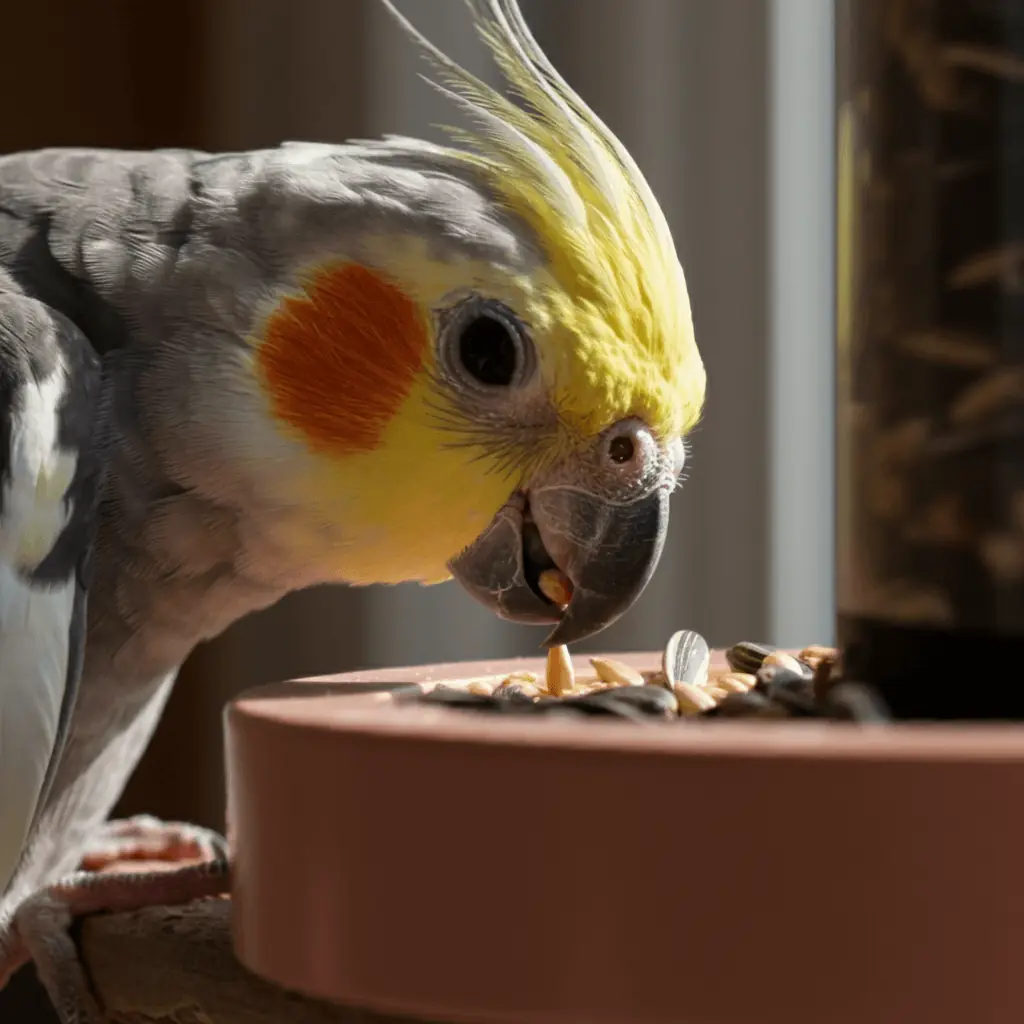
A cockatiel enjoying a nutritious meal, showing the importance of a healthy beak for eating and overall well-being.
Signs of a Healthy Cockatiel Beak
A healthy cockatiel beak is essential for your bird’s daily activities, such as eating, grooming, and playing. So, how can you tell if your cockatiel’s beak is in good shape? Here are some key signs to look for:
- Smooth texture: A healthy beak should have a smooth surface without any cracks or peeling. Minor flaking is normal, but large cracks or rough patches could indicate a problem.
- Symmetry: Both the upper and lower parts of the beak should align properly. If you notice an uneven beak, it might be a sign of overgrowth or injury.
- Normal color: Cockatiels typically have light-colored beaks, usually pale beige or off-white. Any discoloration, such as dark spots or red streaks, could suggest an underlying issue.
- Proper length: While beaks grow continuously, they should wear down naturally through eating and playing. An overly long beak may indicate a lack of proper wear or an underlying health issue.
If your cockatiel’s beak shows these signs, it’s likely in good health. However, if you notice anything unusual, such as chipping, discoloration, or overgrowth, it’s important to take action promptly to avoid further problems. Regular checks can help you catch potential issues early and maintain your bird’s beak in its best condition.
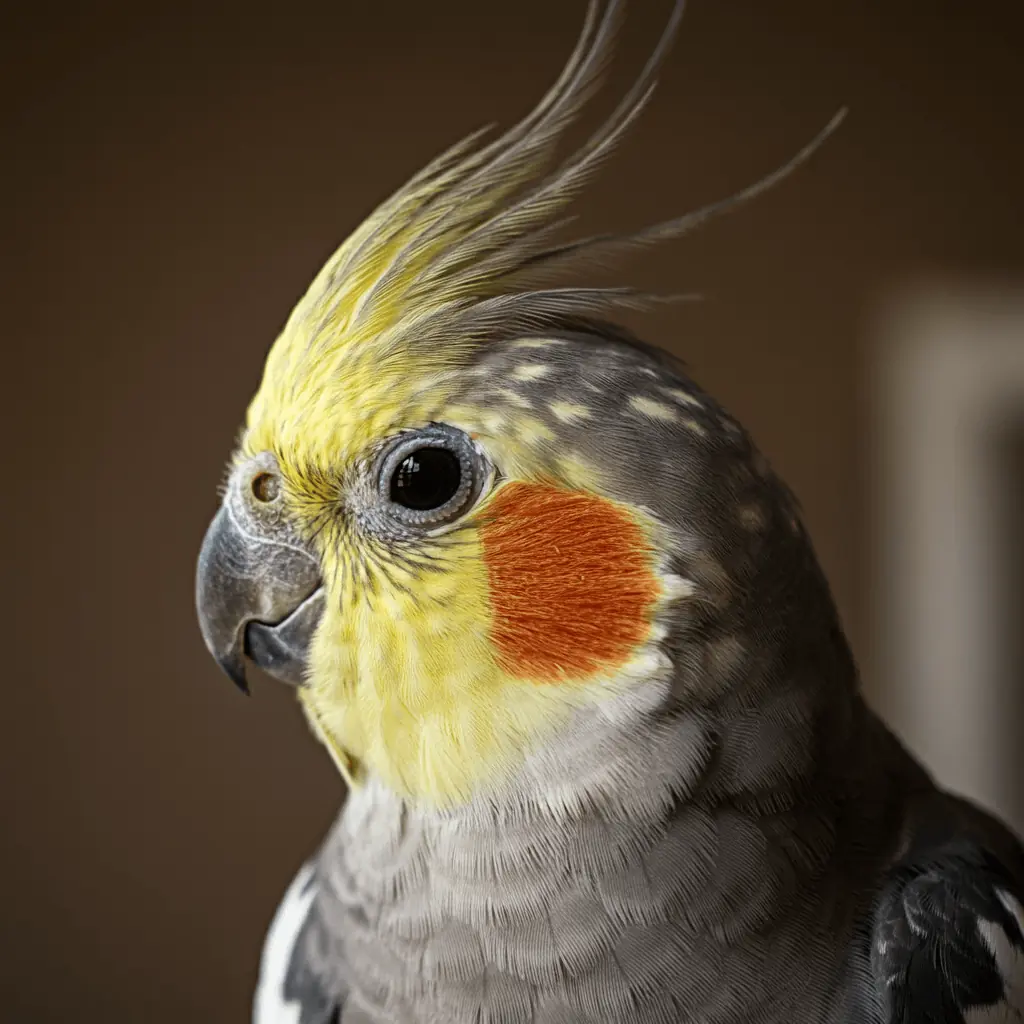
A close-up of a cockatiel’s well-maintained beak, showing smooth texture and proper alignment, essential for eating and grooming.
Common Beak Problems in Cockatiels
Cockatiels can face a variety of beak issues that, if left unchecked, can lead to serious health complications. Being aware of the most common problems and their signs can help you take timely action.
- Beak Overgrowth: One of the most common problems is beak overgrowth. This happens when the beak doesn’t wear down naturally, often due to a lack of chewing or a poor diet. An overgrown beak can make it difficult for your cockatiel to eat and groom properly.
- Cracked or Flaking Beak: Minor flaking is normal as part of the natural growth process, but large cracks or excessive peeling could indicate nutritional deficiencies or dehydration. A cracked beak can be painful for your bird and may need professional treatment.
- Scissor Beak: This is a condition where the upper and lower parts of the beak don’t align properly, often crossing over each other. It’s usually a genetic issue but can also develop due to injury. Scissor beak makes eating difficult and requires veterinary care.
- Beak Discoloration: A healthy cockatiel beak is usually light-colored. If you notice unusual discoloration, such as dark spots or redness, it could be a sign of infection, injury, or liver disease. In such cases, it’s crucial to get your cockatiel examined by a vet.
- Injuries: Beak injuries can occur if your cockatiel chews on unsafe objects or experiences trauma. Even a small injury can be problematic, as the beak is essential for your bird’s ability to eat and groom.
Addressing these common beak problems early is key to keeping your cockatiel healthy. Regularly inspecting your bird’s beak and providing a balanced diet with safe chew toys can help prevent many of these issues.
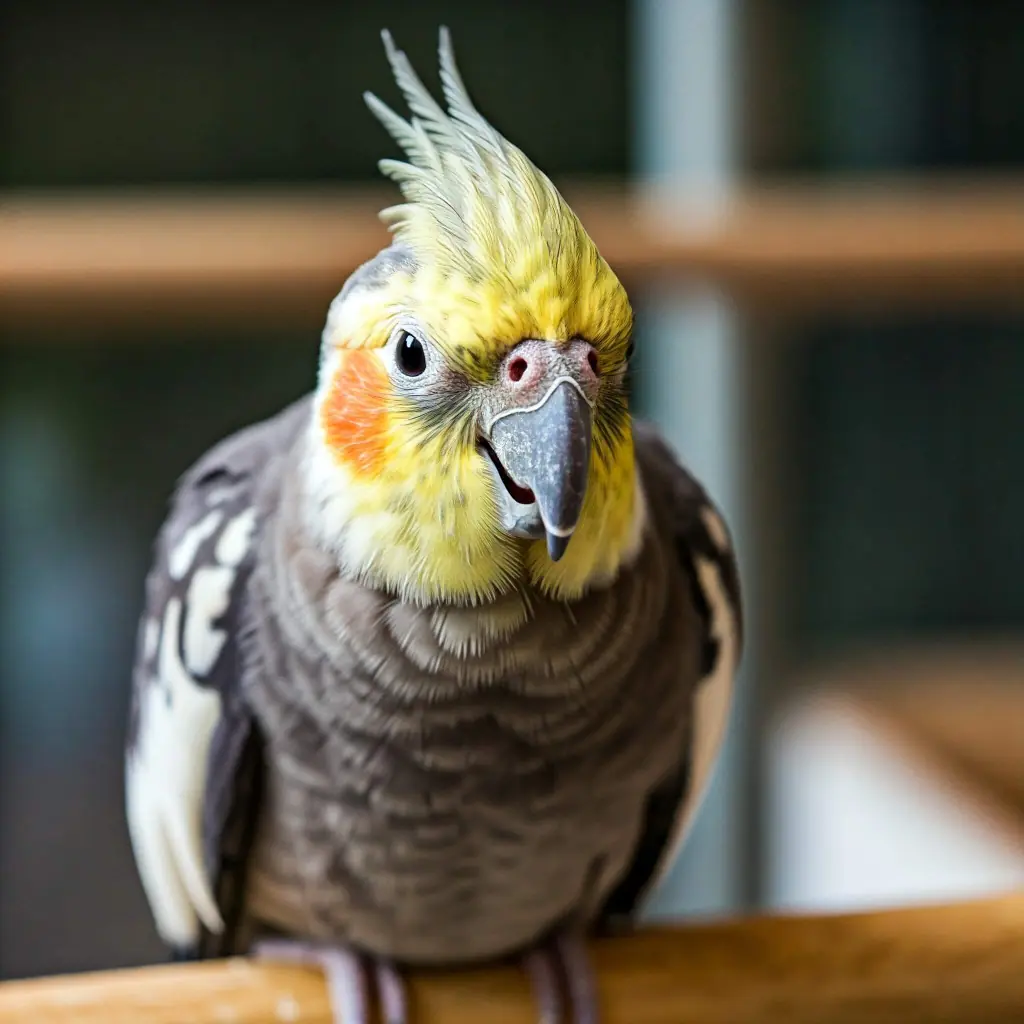
An example of a cockatiel with an overgrown beak, highlighting the need for proper beak care to prevent issues like overgrowth and misalignment.
How to Maintain a Healthy Beak for Your Cockatiel
Maintaining your cockatiel’s beak health is not as difficult as it may seem. With a few simple steps, you can help ensure that your bird’s beak stays strong and well-maintained.
- Provide a Balanced Diet: Nutrition is one of the most important factors in beak health. Foods rich in calcium, such as leafy greens, cuttlebone, and fortified bird pellets, contribute to a strong beak. Avoid feeding your bird too many seeds, as an all-seed diet can lack essential nutrients.
- Offer Safe Chew Toys: Chewing is a natural behavior for cockatiels that helps keep their beaks at the proper length. Make sure your bird has access to safe, bird-friendly chew toys. Wooden toys, mineral blocks, and natural perches are great for this purpose. These not only promote healthy beak wear but also keep your cockatiel mentally stimulated.
- Regular Beak Inspections: It’s a good idea to check your cockatiel’s beak regularly for signs of overgrowth, cracks, or discoloration. This can help you catch potential issues early and seek veterinary care if needed.
- Ensure Proper Perches: The right perches can also help maintain a healthy beak. Natural wood perches, like those made from manzanita or cholla, encourage natural wear of both the beak and claws. Avoid smooth plastic or metal perches, as they don’t provide the same benefits.
- Routine Vet Check-ups: While regular home inspections are important, annual or bi-annual vet visits are a good way to ensure your cockatiel’s beak is in optimal condition. A vet can also trim the beak if it starts to overgrow.
By following these simple steps, you can help maintain your cockatiel’s beak health and avoid many of the common problems that arise from neglect. Keeping your bird’s beak in top shape ensures they can eat, groom, and play comfortably, contributing to their overall happiness and well-being.
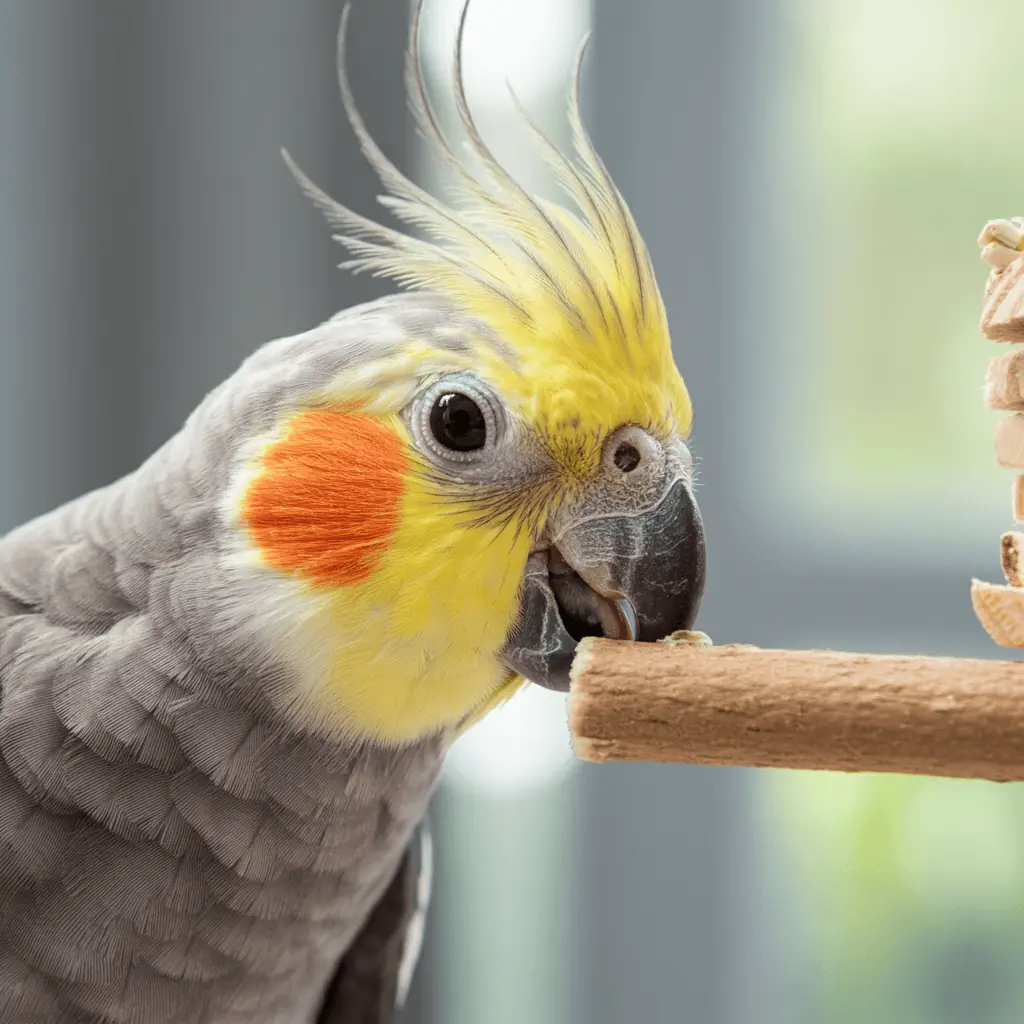
A cockatiel chewing on a bird-safe wooden toy, which helps naturally trim its beak and promotes beak health.
The Role of Diet in Beak Health
A well-balanced diet plays a critical role in maintaining the health of your cockatiel’s beak. Just like the rest of their body, a cockatiel’s beak depends on proper nutrition to stay strong, functional, and free from common issues such as overgrowth or flaking.
- Calcium-Rich Foods: Calcium is essential for strong beak development. Foods like cuttlebone, mineral blocks, and leafy greens (such as kale and spinach) provide the necessary nutrients that keep your cockatiel’s beak in good condition.
- Pellets vs. Seeds: While seeds are a favorite for many birds, an all-seed diet can lack essential nutrients that support beak health. High-quality pellets are a better option as they offer a more balanced nutritional profile, containing everything your cockatiel needs to stay healthy.
- Fruits and Vegetables: Including a variety of fresh fruits and vegetables in your cockatiel’s diet is also beneficial for their beak. Apples (without seeds), carrots, and broccoli, for example, not only add vitamins and minerals but also give your bird something to chew on, promoting natural beak wear.
- Cuttlebone and Mineral Blocks: These are not just diet supplements but also effective tools for beak maintenance. Chewing on cuttlebone or mineral blocks helps trim the beak naturally while providing calcium and other essential minerals.
A poor diet can lead to a variety of beak problems, including weakness, discoloration, and overgrowth. By ensuring your cockatiel receives a nutrient-rich, varied diet, you’ll support their overall health and keep their beak in top shape.
Providing Safe Chew Toys for Beak Maintenance
Chewing is a natural behavior for cockatiels, and it plays an important role in keeping their beaks properly maintained. By offering your bird safe chew toys, you can help ensure that their beak stays at a healthy length and avoid problems like overgrowth or misalignment.
- Wooden Toys: Natural wood toys are a great option for cockatiels. Look for bird-safe woods like pine, manzanita, or balsa. These are soft enough for your cockatiel to chew but durable enough to provide the necessary beak wear.
- Mineral Blocks and Cuttlebones: These not only provide essential nutrients but also help wear down the beak as your bird chews on them. Cuttlebones are especially beneficial because they are high in calcium, which promotes strong beak structure.
- Natural Perches: Perches made from natural wood, such as manzanita or grapevine, encourage both chewing and natural beak wear. They also serve as excellent climbing surfaces, providing mental stimulation for your cockatiel.
- Shredding Toys: Cockatiels love to shred materials, so providing shredding toys made from safe materials like paper or palm leaves can keep them entertained while also helping with beak maintenance.
- Avoid Unsafe Materials: Be cautious when selecting toys. Avoid toys with plastic, paint, or metal that can be harmful if ingested. Always opt for toys specifically designed for birds to ensure safety.
By providing a variety of safe chew toys, you can not only help maintain your cockatiel’s beak but also keep them mentally stimulated and engaged. Chew toys are a simple, effective way to promote natural beak wear and avoid issues like overgrowth.
Regular Beak Inspections and When to See a Vet
Performing regular beak inspections is an important part of maintaining your cockatiel’s overall health. While many beak issues can be managed at home, there are times when professional help is necessary.
- What to Look for During Inspections:
- Smoothness: A healthy beak should be smooth, without deep cracks or peeling. Minor flaking is normal, but excessive peeling may indicate a problem.
- Alignment: The upper and lower parts of the beak should align properly. If you notice misalignment or scissor beak (where the beak crosses over itself), it may need veterinary attention.
- Length: The beak should not appear overly long or too short. Overgrowth can make it difficult for your cockatiel to eat and groom, and it may require trimming.
- Color: Any significant change in color, such as dark spots or red streaks, could be a sign of injury, infection, or a nutritional issue.
- When to See a Vet:
- Overgrown Beak: If the beak grows too long, a vet can trim it safely. Attempting to trim it yourself can be risky and may lead to injury if not done correctly.
- Discoloration or Soft Spots: These could indicate infections or serious conditions such as liver disease. It’s crucial to have a vet examine your bird to determine the cause.
- Cracks or Injuries: Small cracks or chips can worsen over time if not treated. In the case of a beak injury, your cockatiel might have trouble eating or grooming. A vet can provide the appropriate care and treatment.
- Scissor Beak: This misalignment needs to be addressed by a professional to ensure your bird can eat and function properly.
Regularly checking your cockatiel’s beak can help you catch any potential problems early. If you notice anything unusual, it’s always better to consult with a vet to ensure that your bird receives the care it needs.
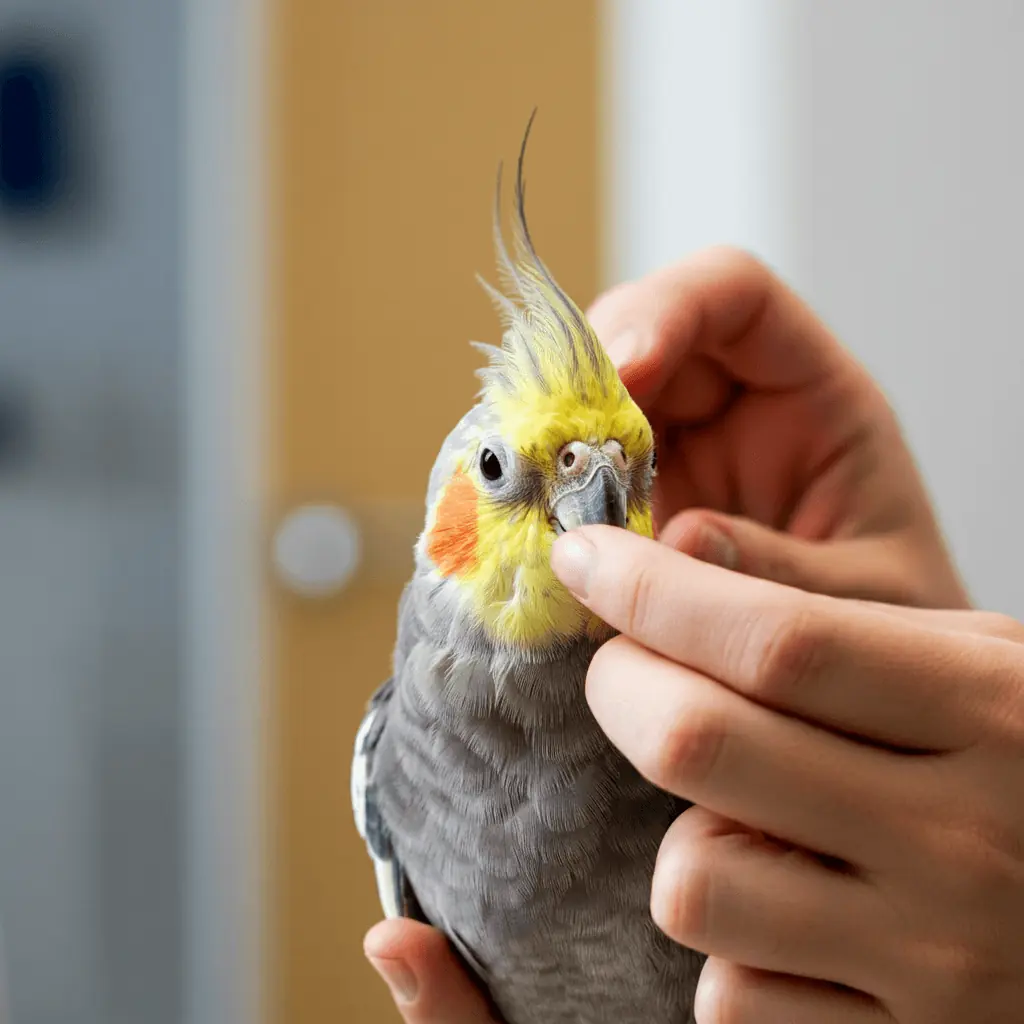
A cockatiel beak inspection in progress, showing the importance of regular checks to maintain a healthy beak and prevent common problems.
How to Trim a Cockatiel’s Beak Safely
In some cases, your cockatiel’s beak might require trimming if it becomes overgrown. However, trimming a bird’s beak can be a delicate task, and it’s often best left to a professional vet. If you feel confident and have consulted with your vet, here’s how you can trim your cockatiel’s beak safely at home:
- Gather the Right Tools: You will need a pair of small bird beak trimmers or a rotary tool designed for pets. Make sure you also have a styptic powder handy in case of bleeding.
- Have a Helper: It’s a good idea to have someone assist you in holding your cockatiel while you perform the trim. Birds can get anxious, and having an extra pair of hands will make the process smoother and safer.
- Hold the Bird Securely: Wrap your cockatiel gently but firmly in a soft towel, leaving only the head exposed. This helps prevent injury and keeps your bird calm.
- Trim Only a Small Amount: When trimming, it’s important to take off only a small amount at a time. The beak has blood vessels and nerves inside, and trimming too much can cause pain and bleeding. Aim to remove just the overgrown tip.
- Smooth the Edges: After trimming, use an emery board or a bird-safe file to gently smooth out any rough edges. This prevents chipping and helps maintain the beak’s natural shape.
- Be Ready to Stop Bleeding: If you accidentally cut too far, use styptic powder to stop the bleeding immediately. Applying gentle pressure with a clean cloth can also help.
- Consult a Vet if Unsure: If you’re not comfortable trimming your bird’s beak or if you notice any abnormalities, it’s always best to consult with a vet. A professional can safely trim the beak and check for underlying issues.
Trimming your cockatiel’s beak can help prevent overgrowth, but it’s important to approach this task carefully. Regular chewing on toys and a healthy diet can reduce the need for beak trims, so make sure your cockatiel has plenty of opportunities to keep their beak naturally maintained.
Preventing Beak Injuries in Cockatiels
Beak injuries can happen for a variety of reasons, such as accidents, rough handling, or chewing on unsafe materials. Since the beak is crucial for your cockatiel’s ability to eat, groom, and explore, preventing injuries should be a top priority. Here are some steps you can take to protect your bird’s beak:
- Provide Safe Toys and Perches: One of the simplest ways to prevent beak injuries is to ensure that your cockatiel has access to bird-safe toys and perches. Avoid giving your bird toys with small, breakable parts, sharp edges, or non-bird-safe materials like certain plastics or metals.
- Supervised Out-of-Cage Time: When your cockatiel is outside its cage, make sure the environment is safe. Remove any hazardous objects, sharp surfaces, or dangerous materials your bird could chew on. Cockatiels are curious and love to explore with their beaks, so supervision is key.
- Avoid Rough Handling: Be gentle when handling your cockatiel. Rough or careless handling can accidentally injure their beak. Encourage anyone interacting with your bird to be gentle and calm to avoid unnecessary stress and risk.
- Watch for Aggressive Behaviors: If you have more than one bird, keep an eye out for any aggressive behavior between them. Birds sometimes peck at each other’s beaks, which can lead to injuries. Make sure each bird has enough space and their own toys to reduce competition.
- Check Perches for Safety: Inspect your bird’s perches regularly. Some perches, especially those made from plastic or metal, can cause beak damage if your cockatiel chews on them. Stick to natural wood perches, which are not only safer but also promote healthy beak wear.
- Ensure a Nutritious Diet: A well-balanced diet helps maintain the strength and resilience of your cockatiel’s beak. Nutrient deficiencies, particularly in calcium, can make the beak more susceptible to injury.
Taking these preventive measures can go a long way in protecting your cockatiel’s beak. A little extra attention to their environment and diet will help ensure your bird stays healthy and injury-free.
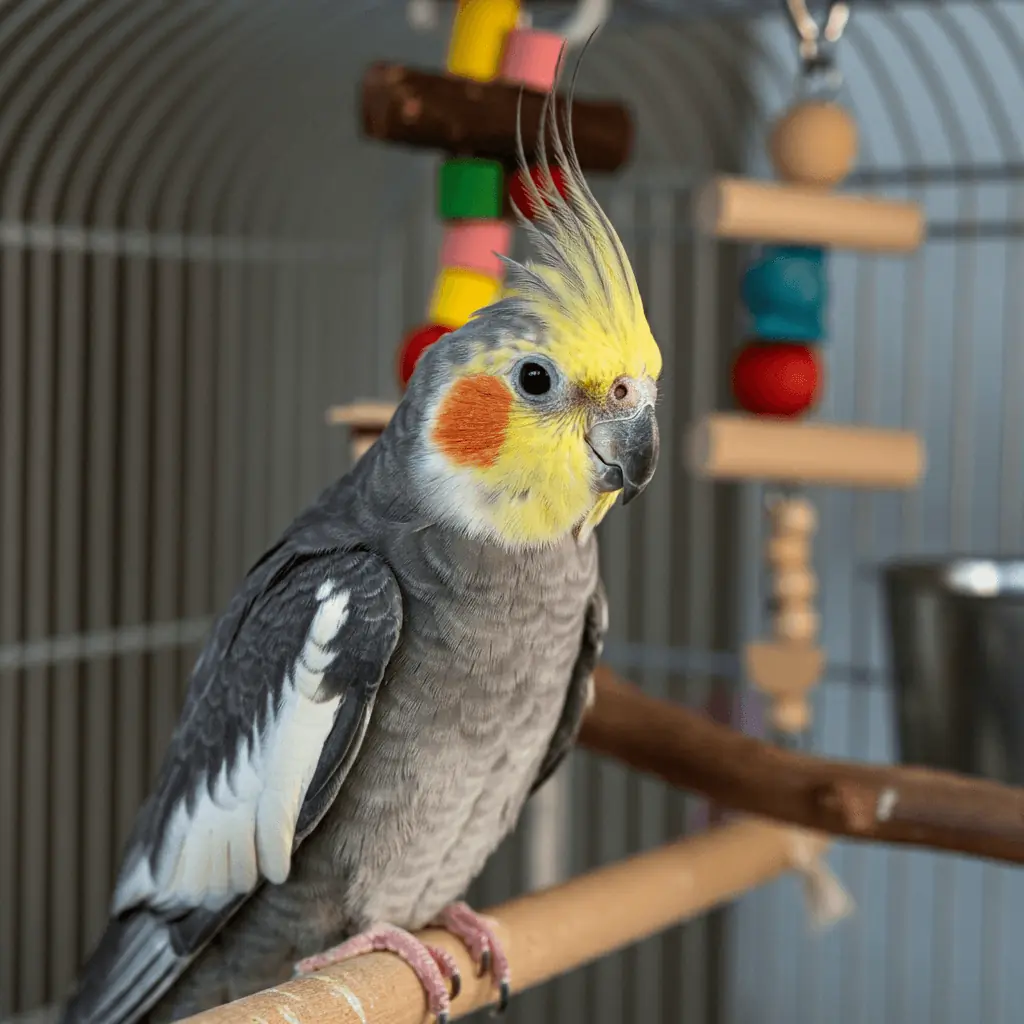
A cockatiel playing with a bird-safe toy inside a well-designed cage, which helps prevent beak injuries and keeps the bird mentally stimulated.
Frequently Asked Questions (FAQs) About Cockatiel Beak Care
1. How often should I trim my cockatiel’s beak?
Most cockatiels do not need regular beak trims if they have a balanced diet and access to chew toys. However, if you notice overgrowth, it’s best to consult a vet before attempting to trim it yourself.
2. What are the signs of an overgrown beak?
An overgrown beak may appear long, curved, or uneven. Your cockatiel may also have difficulty eating, grooming, or using its beak to interact with its environment.
3. Can a cockatiel’s beak grow back if damaged?
Yes, cockatiel beaks can regrow after minor injuries. However, serious injuries or cracks can lead to permanent damage, and it’s important to seek veterinary care if your bird sustains a beak injury.
4. How can I prevent my cockatiel’s beak from overgrowing?
Providing safe chew toys, a nutritious diet, and natural wood perches will help wear down your cockatiel’s beak naturally. Routine beak inspections will also help you catch any early signs of overgrowth.
5. What should I do if my cockatiel’s beak is cracked or chipped?
Minor cracks or chips can heal on their own, but if the damage is severe, you should contact a vet immediately. Avoid handling the beak too much, and provide soft food until the beak heals.
6. Are there any beak health supplements for cockatiels?
Yes, you can provide cuttlebone or mineral blocks, which offer important nutrients like calcium that help maintain a strong and healthy beak.
7. Why does my cockatiel’s beak have dark spots?
Dark spots on a cockatiel’s beak could be a sign of injury, infection, or liver disease. If you notice discoloration, it’s best to get your cockatiel examined by a vet to rule out serious conditions.
8. How can I tell if my cockatiel’s beak is healthy?
A healthy beak should be smooth, symmetrical, and free of cracks or discoloration. It should also be the right length, not too long or too short, and aligned properly.
Final Thoughts on Cockatiel Beak Care
Caring for your cockatiel’s beak is essential for their overall health and well-being. By providing a balanced diet, safe chew toys, and regular beak inspections, you can help maintain a healthy beak and prevent common issues such as overgrowth or injury. Remember that regular vet visits are also important, especially if you notice any unusual signs like discoloration, cracks, or misalignment. With proper care, your cockatiel’s beak will remain in great condition, allowing them to eat, groom, and explore their world with ease.
Ensuring your bird’s beak health is a simple yet crucial part of their overall care, and with the right approach, you can prevent most beak-related problems. Be proactive, pay attention to changes, and consult a vet when necessary—your cockatiel will thank you with a long, healthy life.

